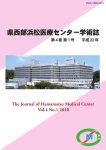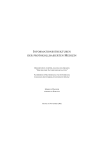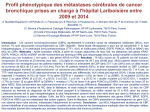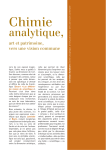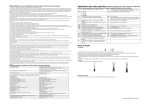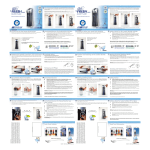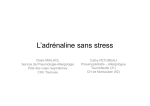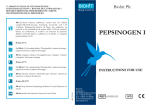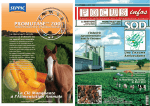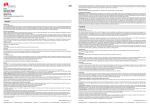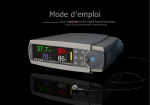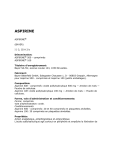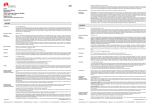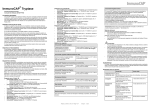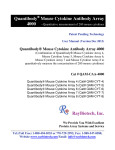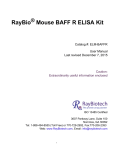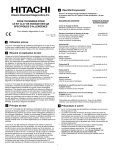Download FLEX Monoclonal Mouse Anti-Human Mast Cell Tryptase
Transcript
If the protocols are not available on the used Dako Autostainer instrument, please contact Dako Technical Services. Optimal conditions may vary depending on specimen and preparation methods, and should be determined by each individual laboratory. If the evaluating pathologist should desire a different staining intensity, a Dako Application Specialist/Technical Service Specialist can be contacted for information on re-programming of the protocol. Verify that the performance of the adjusted protocol is still valid by evaluating that the staining pattern is identical to the staining pattern described in “Performance characteristics”. FLEX Monoclonal Mouse Anti-Human Mast Cell Tryptase Clone AA1 Ready-to-Use (Dako Autostainer/Autostainer Plus) Counterstaining in hematoxylin is recommended using EnVision FLEX Hematoxylin, (Dako Autostainer/Autostainer Plus) (Code K8018). Nonaqueous, permanent mounting medium is recommended. Positive and negative controls should be run simultaneously using the same protocol as the patient specimens. The positive control tissue should include tonsil and the cells/structures should display reaction patterns as described for this tissue in “Performance characteristics” in all positive specimens. The recommended negative control reagent is FLEX Negative Control, Mouse, (Dako Autostainer/Autostainer Plus) (Code IS750). Code IS640 Staining interpretation Cells labeled by the antibody display granular cytoplasmic staining (6). Performance characteristics Normal tissues: The antibody specifically labels mast cells (MC) in a number of human tissues, including lung, tonsil, colon, gastric mucosa and skin, whereas only a few MCs are detectable in the pituitary gland. The antibody does not label basophils or any other normal blood leukocytes, likewise, no labeling has been observed in keratinocytes (6). Mast cells in the tonsil show a moderate to strong staining reaction. 2 Abnormal tissues: In a study of more than 150 cases of different MC disorders, it was demonstrated that <4 MCs/mm were labeled in bone marrow in most normal and reactive states, whereas >5 but <100 were labeled in myelodysplastic syndromes. More than 100 MCs/mm2 were detected in MC neoplasias, and cases with a much higher number (maximum 2655 MCs/mm2) were often observed (1). ENGLISH Intended use For in vitro diagnostic use. FLEX Monoclonal Mouse Anti-Human Mast Cell Tryptase, Clone AA1, Ready-to-Use (Dako Autostainer/Autostainer Plus), is intended for use in immunohistochemistry together with Dako Autostainer/Autostainer Plus instruments. This antibody labels human mast cells and is useful for the identification of very atypical or immature mast cells (MC) in mast cell leukemia, and for the detection of small, even minute, dense focal MC infiltrates in staging procedures in patients with known cutaneous mastocytosis (1). The clinical interpretation of any staining or its absence should be complemented by morphological studies using proper controls and should be evaluated within the context of the patient's clinical history and other diagnostic tests by a qualified pathologist. Summary and explanation Human mast cell tryptases (EC 3.4.21.59) comprise a family of trypsin-like neutral serine proteases that are predominantly expressed in mast cells (2). In its enzymatically active form, mast cell tryptase exists as a non-covalently linked tetramer of 132 kDa (2, 3). Mast cell tryptase is capable of degrading vasoactive intestinal peptide and activating prekallikrein as well as generating kinins, all important mediators involved in bronchoconstriction and airway hyperresponsiveness, which are major contributors to allergic airway disease (2). Mast cells are activated by a number of stimuli, including antigen, superoxides, complement protein, neuropeptides and lipoproteins, resulting in activation and degranulation. Mast cells play an active role in such diverse diseases as atherosclerosis, asthma, arthritis, bile duct fibrosis, malignancy and pulmonary fibrosis (4, 5). Identification of mast cells through staining of tissues with antibodies specific for human mast cell tryptase has been useful in identification of focal and diffuse MC infiltrates in primary MC disease and mastocytosis. Demonstration of mast cell tryptase is essential for the identification of highly atypical, hypogranulated or even non-metachromatic MCs, especially in MC leukemia, and for the detection of small or minute MC infiltrates (1). Refer to Dako’s General Instructions for Immunohistochemical Staining or the detection system instructions of IHC procedures for: 1) Principle of Procedure, 2) Materials Required, Not Supplied, 3) Storage, 4) Specimen Preparation, 5) Staining Procedure, 6) Quality Control, 7) Troubleshooting, 8) Interpretation of Staining, 9) General Limitations. Reagent provided Ready-to-use monoclonal mouse antibody provided in liquid form in a buffer containing stabilizing protein and 0.015 mol/L sodium azide. Clone: AA1 (3). Isotype: IgG1, kappa. Immunogen Mast cell tryptase isolated from human lung (3). Specificity In Western blotting of a tryptase-rich extract of human lung under reducing conditions, the antibody labels a band of approximately 32.5 kDa corresponding to human mast cell tryptase (3). In indirect ELISA the antibody reacts with purified human mast cell tryptase (3). Antibody-binding to the mast cell tryptase does not affect enzyme activity (3). Periodate treatment of mast cell tryptase has no effect on antibody labeling, indicating that carbohydrate epitopes are not involved in antibody recognition. Nor is antibody recognition affected by the presence of heparin (3). Precautions 1. For professional users. 2. This product contains sodium azide (NaN3), a chemical highly toxic in pure form. At product concentrations, though not classified as hazardous, sodium azide may react with lead and copper plumbing to form highly explosive build-ups of metal azides. Upon disposal, flush with large volumes of water to prevent metal azide build-up in plumbing. 3. As with any product derived from biological sources, proper handling procedures should be used. 4. Wear appropriate Personal Protective Equipment to avoid contact with eyes and skin. 5. Unused solution should be disposed of according to local, State and Federal regulations. Storage Store at 2-8 °C. Do not use after expiration date sta mped on vial. If reagents are stored under any conditions other than those specified, the conditions must be verified by the user. There are no obvious signs to indicate instability of this product. Therefore, positive and negative controls should be run simultaneously with patient specimens. If unexpected staining is observed which cannot be explained by variations in laboratory procedures and a problem with the antibody is suspected, contact Dako Technical Support. Specimen preparation including materials required but not supplied Staining procedure including materials required but not supplied The antibody can be used for labeling formalin-fixed, paraffin-embedded tissue sections. Tissue specimens should be cut into sections of approximately 4 µm. Pre-treatment with heat-induced epitope retrieval (HIER) is required using Dako PT Link (Code PT100/PT101). For details, please refer to the PT Link User Guide. Optimal results are obtained by pretreating tissues using EnVision FLEX Target Retrieval Solution, High pH (50x) (Code K8010/K8004). Paraffin-embedded sections: Pre-treatment of formalin-fixed, paraffin-embedded tissue sections is recommended using the 3-in-1 specimen preparation procedure for Dako PT Link. Follow the pre-treatment procedure outlined in the package insert for EnVision FLEX Target Retrieval Solution, High pH (50x) (Code K8010/K8004). Note: After staining the sections must be dehydrated, cleared and mounted using permanent mounting medium. Deparaffinized sections: Pre-treatment of deparaffinized formalin-fixed, paraffin-embedded tissue sections is recommended using Dako PT Link and following the same procedure as described for paraffin-embedded sections. After staining the slides should be mounted using aqueous or permanent mounting medium. The tissue sections should not dry out during the treatment or during the following immunohistochemical staining procedure. For greater adherence of tissue sections to glass slides, the use of FLEX IHC Microscope Slides (Code K8020) is recommended. FRANÇAIS Utilisation prévue Pour utilisation lors d’un diagnostic in vitro. FLEX Monoclonal Mouse Anti-Human Mast Cell Tryptase, Clone AA1, Ready-to-Use (Dako Autostainer/Autostainer Plus), est destiné à une utilisation en immunohistochimie avec les instruments Dako Autostainer/Autostainer Plus. Cet anticorps marque les mastocytes humains et permet l'identification de mastocytes très atypiques ou immatures (MC) dans la leucémie à mastocytes et pour la détection de petits, et même minuscules, infiltrats denses focalisés dans les procédures de catégorisation de patients atteints d'une mastocytose cutanée connue (1). L’interprétation clinique de toute coloration ou son absence doit être complétée par des études morphologiques en utilisant des contrôles appropriés et doit être évaluée en fonction des antécédents cliniques du patient et d’autres tests diagnostiques par un pathologiste qualifié. Résumé et explication Les tryptases des mastocytes humains (EC 3.4.21.59) comprennent une famille de protéases à sérine neutre similaire à la trypsine, qui sont exprimées de manière prépondérante dans les mastocytes (2). Dans sa forme active du point de vue enzymatique, la tryptase des mastocytes existe sous la forme d'un tétramère de 132 kDa, lié de manière non covalente (2, 3). La tryptase des mastocytes est capable de dégrader les peptides intestinaux vasoactifs et d'activer la prékallicréine ainsi que de générer des kinines, qui sont toutes d'importants médiateurs impliqués dans la broncho-constriction et l'hypersensibilité des vois aériennes, qui contribuent dans une large mesure aux maladies allergiques des voies aériennes (2). Les mastocytes sont activés par un certain nombre de stimuli, notamment les antigènes, les superoxydes, les protéines du complément, les neuropeptides et les lipoprotéines, entraînant une activation et une dégranulation. Les mastocytes jouent un rôle actif dans des maladies diverses comme l'athérosclérose, l'asthme, l'arthrite, la fibrose du canal biliaire, les tumeurs et la fibrose pulmonaire (4, 5). L'identification de mastocytes, grâce à la coloration de tissus par des anticorps spécifiques à la tryptase des mastocytes humains, a permis l'identification d'infiltrats circonscrits ou diffus de MC dans la maladie primaire à mastocytes et la mastocytose. Faire la preuve de la présence de la tryptase de mastocyte est essentiel pour l'identification de mastocytes hautement atypiques, hypogranulés ou même non métachromatiques, surtout dans la leucémie à mastocytes et pour la détection des infiltrats de mastocytes de petite ou très petite taille (1). Se référer aux Instructions générales de coloration immunohistochimique de Dako ou aux instructions du système de détection relatives aux procédures IHC pour plus d’informations concernant les points suivants : 1) Principe de procédure, 2) Matériels requis mais non fournis, 3) Conservation, 4) Préparation des échantillons, 5) Procédure de coloration, 6) Contrôle qualité, 7) Dépannage, 8) Interprétation de la coloration, 9) Limites générales. Réactifs fournis Anticorps monoclonal de souris prêt à l’emploi, fourni sous forme liquide dans un tampon contenant une protéine stabilisante et 0,015 mol/L d’azide de sodium. Clone : AA1 (3). Isotype : IgG1, kappa. Immunogène Tryptase de mastocyte isolée dans le poumon humain (3). Spécificité Dans le Western blot d'un extrait de poumon humain, riche en tryptase dans des conditions réductrices, l'anticorps marque une bande d'environ 32,5 kDa, correspondant à la tryptase de mastocyte humain (3). Par test ELISA indirect, l'anticorps réagit avec la tryptase de mastocyte humain purifiée (3). La liaison de l'anticorps à la tryptase de mastocyte n'affecte pas l'activité enzymatique (3). Le traitement au périodate de la tryptase de mastocyte n'a aucun effet sur le marquage par l'anticorps, indiquant que les épitopes à hydrates de carbone ne sont pas impliqués dans la reconnaissance de l'anticorps. La reconnaissance de l'anticorps n'est pas affectée non plus par la présence de l'héparine (3). Précautions 1. Pour utilisateurs professionnels. 2. Ce produit contient de l’azide de sodium (NaN3), produit chimique hautement toxique dans sa forme pure. Aux concentrations du produit, bien que non classé comme dangereux, l’azide de sodium peut réagir avec le cuivre et le plomb des canalisations et former des accumulations d’azides métalliques hautement explosifs. Lors de l’élimination, rincer abondamment à l’eau pour éviter toute accumulation d’azide métallique dans les canalisations. 3. Comme avec tout produit d’origine biologique, des procédures de manipulation appropriées doivent être respectées. 4. Porter un vêtement de protection approprié pour éviter le contact avec les yeux et la peau. 5. Les solutions non utilisées doivent être éliminées conformément aux réglementations locales et nationales. Conservation Conserver entre 2 et 8 °C. Ne pas utiliser après la date de péremption indiquée sur le flacon. Si les réactifs sont conservés dans des conditions autres que celles indiquées, celles-ci doivent être validées par l’utilisateur. Il n’y a aucun signe évident indiquant l’instabilité de ce produit. Par conséquent, des contrôles positifs et négatifs doivent être testés en même temps que les échantillons de patient. Si une coloration inattendue est observée, qui ne peut être expliquée par un changement des procédures du laboratoire, et en cas de suspicion d’un problème lié à l’anticorps, contacter l’assistance technique de Dako. Préparation des échantillons y compris le matériel requis mais non fourni L’anticorps peut être utilisé pour le marquage des coupes de tissus inclus en paraffine et fixés au formol. L’épaisseur des coupes d’échantillons de tissu doit être d’environ 4 µm. Un prétraitement avec démasquage d’épitope induit par la chaleur (HIER) est nécessaire avec le Dako PT Link (Réf. PT100/PT101). Pour plus de détails, se référer au Guide d’utilisation du PT Link. Des résultats optimaux sont obtenus en prétraitant les tissus à l’aide de la EnVision FLEX Target Retrieval Solution, High pH (50x) (Réf. K8010/K8004). Coupes incluses en paraffine : le prétraitement des coupes tissulaires fixées au formol et incluses en paraffine est recommandé à l'aide de la procédure de préparation d'échantillon 3-en-un pour le Dako PT Link. Suivre la procédure de prétraitement indiquée dans la notice de la EnVision FLEX Target Retrieval Solution, High pH (50x) (Réf. K8010/K8004). Remarque : après coloration, les coupes doivent être déshydratées, lavées et montées à l’aide d’un milieu de montage permanent. Coupes déparaffinées : le prétraitement des coupes tissulaires déparaffinées, fixées au formol et incluses en paraffine, est recommandé à l’aide du Dako PT Link, en suivant la même procédure que pour les coupes incluses en paraffine. Après coloration, un montage aqueux ou permanent des lames est recommandé. IS640/EFG/MNI/2009.12.04 p. 2/4 The recommended visualization system is EnVision FLEX, High pH, (Dako Autostainer/Autostainer Plus) (Code K8010). The staining steps and incubation times are pre-programmed into the software of Dako Autostainer/Autostainer Plus instruments, using the following protocols: Template protocol: FLEXRTU2 (200 µL dispense volume) or FLEXRTU3 (300 µL dispense volume) Autoprogram: Trypt (without counterstaining) or TryptH (with counterstaining) The Auxiliary step should be set to “rinse buffer” in staining runs with ≤10 slides. For staining runs with >10 slides the Auxiliary step should be set to “none”. This ascertains comparable wash times. All incubation steps should be performed at room temperature. For details, please refer to the Operator’s Manual for the dedicated instrument. (117438-002) Dako Denmark A/S IS640/EFG/MNI/2009.12.04 p. 1/4 | Produktionsvej 42 | DK-2600 Glostrup | Denmark | Tel. +45 44 85 95 00 | Fax +45 44 85 95 95 | CVR No. 33 21 13 17 (117438-002) Dako Denmark A/S | Produktionsvej 42 | DK-2600 Glostrup | Denmark | Tel. +45 44 85 95 00 | Fax +45 44 85 95 95 | CVR No. 33 21 13 17 Les coupes de tissus ne doivent pas sécher lors du traitement ni lors de la procédure de coloration immunohistochimique suivante. Pour une meilleure adhérence des coupes de tissus sur les lames de verre, il est recommandé d’utiliser des lames FLEX IHC Microscope Slides (Réf. K8020). Procédure de coloration y compris le matériel requis mais non fourni Le système de visualisation recommandé est le EnVision FLEX, High pH, (Dako Autostainer/Autostainer Plus) (Code K8010). Les étapes de coloration et les temps d’incubation sont préprogrammés dans le logiciel des instruments Dako Autostainer/Autostainer Plus, à l’aide des protocoles suivants : Protocole modèle : FLEXRTU2 (volume d’application de 200 µL) ou FLEXRTU3 (volume d’application de 300 µL) Programme automatique : Trypt (sans contre-coloration) ou TryptH (avec contre-coloration) L’étape Auxiliary doit être réglée sur « rinse buffer » lors des cycles de coloration avec ≤10 lames. Pour les cycles de coloration de >10 lames, l’étape Auxiliary doit être réglée sur « none ». Cela confirme des temps de lavage comparables. Toutes les étapes d’incubation doivent être effectuées à température ambiante. Pour plus de détails, se référer au Manuel de l’opérateur spécifique à l'instrument. Si les protocoles ne sont pas disponibles sur l’instrument Dako Autostainer utilisé, contacter le service technique de Dako. Les conditions optimales peuvent varier en fonction du prélèvement et des méthodes de préparation, et doivent être déterminées par chaque laboratoire individuellement. Si le pathologiste qui réalise l’évaluation désire une intensité de coloration différente, un spécialiste d’application/spécialiste du service technique de Dako peut être contacté pour obtenir des informations sur la reprogrammation du protocole. Vérifier que l'exécution du protocole modifié est toujours valide en vérifiant que le schéma de coloration est identique au schéma de coloration décrit dans les « Caractéristiques de performance ». Il est recommandé d’effectuer une contre-coloration à l’aide d’hématoxyline EnVision FLEX Hematoxylin, (Dako Autostainer/Autostainer Plus) (Code K8018). L’utilisation d’un milieu de montage permanent non aqueux est recommandée. Des contrôles positifs et négatifs doivent être réalisés en même temps et avec le même protocole que les échantillons du patient. Le contrôle de tissu positif doit comprendre l’amygdale et les cellules/structures doivent présenter les schémas de réaction décrits pour ces tissus dans les « Caractéristiques de performance » pour tous les échantillons positifs. Le contrôle négatif recommandé est le FLEX Negative Control, Mouse, (Dako Autostainer/Autostainer Plus) (Code IS750). Interprétation de la coloration Les cellules marquées par l’anticorps présentent une coloration cytoplasmique granulaire (6). Caractéristiques de performance Tissus sains : l'anticorps marque spécifiquement les mastocytes (MC) dans un certain nombre de tissus humains, notamment le poumon, l'amygdale, le côlon, la muqueuse gastrique et la peau, tandis que seuls quelques MC sont détectables au niveau de l'hypophyse. L'anticorps ne marque pas les basophiles ni aucun autre leucocyte normal du sang, et de la même manière, aucun marquage des kératinocytes n'a été observé (6). Les mastocytes de l’amygdale présentent une coloration modérée à forte. Tissus anormaux : dans une étude portant sur plus de 150 cas de divers troubles des MC, il a été démontré que <4 MC/mm2 étaient marqués dans la moelle osseuse dans la plupart des cas normaux et réactifs, tandis que >5 mais <100 étaient marqués dans les syndromes myélodysplasiques. Plus de 100 MC/mm2 étaient détectés dans les néoplasies à MC et des cas avec un nombre encore plus élevé (maximum 2655 MC/mm2) ont été souvent observés (1). Lagerung Bei 2–8 °C aufbewahren. Nach Ablauf des auf dem Fläsch chen aufgedruckten Verfalldatums nicht mehr verwenden. Werden die Reagenzien unter anderen als den angegebenen Bedingungen aufbewahrt, müssen diese Bedingungen vom Benutzer validiert werden. Es gibt keine offensichtlichen Anzeichen für eine eventuelle Produktinstabilität. Positiv- und Negativkontrollen sollten daher zur gleichen Zeit wie die Patientenproben getestet werden. Falls es zu einer unerwarteten Färbung kommt, die sich nicht durch Unterschiede bei Laborverfahren erklären lässt und auf ein Problem mit dem Antikörper hindeutet, ist der technische Kundendienst von Dako zu verständigen. Vorbereitung der Probe und erforderliche, aber nicht mitgelieferte Materialien Der Antikörper eignet sich zur Markierung von formalinfixierten und paraffineingebetteten Gewebeschnitten. Gewebeproben sollten in Schnitte von ca. 4 µm Stärke geschnitten werden. Die Vorbehandlung durch hitzeinduzierte Epitopdemaskierung (HIER) mit Dako PT Link (Code-Nr. PT100/PT101) ist erforderlich. Weitere Informationen hierzu siehe PT Link-Benutzerhandbuch. Optimale Ergebnisse können durch Vorbehandlung der Gewebe mit EnVision FLEX Target Retrieval Solution, High pH (50x) (Code-Nr. K8010/K8004) erzielt werden. Paraffineingebettete Schnitte: Die Vorbehandlung der formalinfixierten, paraffineingebetteten Schnitte mit dem 3-in-1Probenvorbereitungsverfahren für Dako PT Link wird empfohlen. Vorbehandlung gemäß der Beschreibung in der Packungsbeilage für EnVision FLEX Target Retrieval Solution, High pH (50x) (Code-Nr. K8010/K8004) durchführen. Hinweis: Nach dem Färben müssen die Schnitte dehydriert, geklärt und mit permanentem Einbettmedium auf den Objektträger aufgebracht werden. Entparaffinierte Schnitte: Eine Vorbehandlung der entparaffinierten, formalinfixierten, paraffineingebetteten Gewebeschnitte mit Dako PT Link nach demselben Verfahren, wie für die paraffineingebetteten Schnitte beschrieben, wird empfohlen. Die Objektträger nach dem Färben mit einem wässrigen oder permanenten Einbettmedium bedecken. Die Gewebeschnitte dürfen während der Behandlung oder des anschließenden immunhistochemischen Färbeverfahrens nicht austrocknen. Zur besseren Haftung der Gewebeschnitte an den Glasobjektträgern wird die Verwendung von FLEX IHC Microscope Slides (Code-Nr. K8020) empfohlen. Färbeverfahren und erforderliche, aber nicht mitgelieferte Materialien Als Visualisierungssystem wird EnVision FLEX, High pH, (Dako Autostainer/Autostainer Plus) Code-Nr. K8010) empfohlen. Die Färbeschritte und Inkubationszeiten sind in der Software der Dako Autostainer/Autostainer Plus-Geräte mit den folgenden Protokollen vorprogrammiert: Matrix-Protokoll: FLEXRTU2 (200 µL Anwendungsvolumen) oder FLEXRTU3 (300 µL Anwendungsvolumen) Autoprogramm: Trypt (ohne Gegenfärbung) oder TryptH (mit Gegenfärbung) Bei Färbedurchläufen mit höchstens 10 Objektträgern sollte der „Zusatz“-Schritt auf „Pufferspülgang“ eingestellt werden. Für Färbedurchläufe mit mehr als 10 Objektträgern den Zusatz-Schritt auf „Keine“ einstellen. Dies gewährleistet vergleichbare Waschzeiten. Alle Inkubationsschritte sollten bei Raumtemperatur durchgeführt werden. Nähere Einzelheiten bitte dem Benutzerhandbuch für das jeweilige Gerät entnehmen. Wenn die Färbeprotokolle auf dem verwendeten Dako Autostainer-Gerät nicht verfügbar sind, bitte den Technischen Kundendienst von Dako verständigen. Optimale Bedingungen können je nach Probe und Präparationsverfahren unterschiedlich sein und sollten vom jeweiligen Labor selbst ermittelt werden. Falls der beurteilende Pathologe eine andere Färbungsintensität wünscht, kann ein Anwendungsspezialist oder Kundendiensttechniker von Dako bei der Neuprogrammierung des Protokolls helfen. Die Leistung des angepassten Protokolls muss verifiziert werden, indem gewährleistet wird, dass das Färbemuster mit dem unter „Leistungsmerkmale“ beschriebenen Färbemuster identisch ist. Die Gegenfärbung in Hämatoxylin sollte mit EnVision FLEX Hematoxylin (Dako Autostainer/Autostainer Plus) (Code-Nr. K8018) ausgeführt werden. Empfohlen wird ein nichtwässriges, permanentes Fixiermittel. Positiv- und Negativkontrollen sollten zur gleichen Zeit und mit demselben Protokoll wie die Patientenproben getestet werden. Das positive Kontrollgewebe sollte Mandelgewebe enthalten, und die Zellen/Strukturen müssen in allen positiven Proben die für dieses Gewebe unter „Leistungsmerkmale“ beschriebenen Reaktionsmuster aufweisen. Das empfohlene Negativ-Kontrollreagenz ist FLEX Negative Control, Mouse, (Dako Autostainer/Autostainer Plus) (Code-Nr. IS750). DEUTSCH Verwendungszweck Zur In-vitro-Diagnostik. FLEX Monoclonal Mouse Anti-Human Mast Cell Tryptase, Klon AA1, Ready-to-Use (Dako Autostainer/Autostainer Plus), ist zur Verwendung in der Immunhistochemie in Verbindung mit Dako Autostainer/Autostainer Plus-Geräten bestimmt. Der Antikörper markiert menschliche Mastzellen und dient zur Identifizierung äußerst atypischer oder unausgereifter Mastzellen (MZ) bei Mastzellenleukämie sowie für den Nachweis von kleinen, oder sogar winzigen, dichten fokalen MZ-Infiltraten bei der Stadieneinteilung von Patienten mit diagnostizierter kutaner Mastozytose (1). Die klinische Auswertung einer eventuell eintretenden Färbung sollte durch morphologische Studien mit geeigneten Kontrollen ergänzt werden und von einem qualifizierten Pathologen unter Berücksichtigung der Krankengeschichte und anderer diagnostischer Tests des Patienten vorgenommen werden. Zusammenfassung und Erklärung Humane Mastzell-Tryptasen (EC 3.4.21.59) bilden eine Familie Trypsin-ähnlicher, neutraler Serin-Proteasen, die überwiegend in Mastzellen exprimiert werden (2). In ihrer enzymatisch aktiven Form existiert die Mastzell-Tryptase als nicht kovalent-gebundenes Tetramer von 132 kDa (2, 3). Die Mastzell-Tryptase ist fähig, vasoaktive intestinale Peptide abzubauen und Präkallikrein zu aktivieren sowie Kinine zu generieren, wobei dies alles wichtige Mediatoren sind, die an der Bronchokonstriktion und Überreaktion der Atemwege beteiligt sind, und somit einen bedeutenden Beitrag zu allergischen Erkrankungen der Atemwege leisten (2). Mastzellen werden durch eine Reihe von Stimuli aktiviert, wie beispielsweise Antigen, Superoxide, Komplement-Protein, Neuropeptide und Lipoproteine, die zu einer Aktivierung und Degranulation der Mastzellen führen. Mastzellen spielen eine aktive Rolle bei solch unterschiedlichen Krankheiten wie Atherosklerose, Asthma, Arthritis, Gallengangfibrose sowie Malignitäten und pulmonaler Fibrose (4, 5). Die Methode zur Identifizierung von Mastzellen durch Anfärben von Geweben mit Antikörpern, die für die menschliche Mastzell-Tryptase spezifisch sind, hat sich bei der Identifizierung fokaler und diffuser MZ-Infiltrate bei primärer MZ-Krankheit und Mastozytose als nützlich erwiesen. Der Nachweis der Mastzell-Tryptase ist für die Identifizierung von äußerst atypischen, hypogranulierten oder sogar nichtmetachromatischen Mastzellen, insbesondere bei der Mastzellenleukämie, sowie für die Entdeckung von kleinen oder winzigen MZ-Infiltraten von entscheidender Bedeutung (1). Folgende Angaben bitte den Allgemeinen Richtlinien zur immunhistochemischen Färbung von Dako oder den Anweisungen des Detektionssystems für IHC-Verfahren entnehmen: 1) Verfahrensprinzip, 2) Erforderliche, aber nicht mitgelieferte Materialien, 3) Aufbewahrung, 4) Vorbereitung der Probe, 5) Färbeverfahren, 6) Qualitätskontrolle, 7) Fehlersuche und -behebung, 8) Auswertung der Färbung, 9) Allgemeine Beschränkungen. Geliefertes Reagenz Gebrauchsfertiger, monoklonaler Maus-Antikörper in flüssiger Form in einem Puffer, der stabilisierendes Protein und 0,015 mol/L Natriumazid enthält. Klon: AA1 (3). Isotyp: IgG1, Kappa. Immunogen Aus der menschlichen Lunge isolierte Mastzell-Tryptase (3). Spezifität Beim Western-Blotting eines Tryptase-reichen Extrakts der menschlichen Lunge markiert der Antikörper unter reduzierenden Bedingungen eine Bande von ungefähr 32,5 kDa, die der menschlichen Mastzell-Tryptase entspricht (3). Im indirekten ELISA-Verfahren reagiert der Antikörper mit gereinigter menschlicher Mastzell-Tryptase (3). Eine Bindung des Antikörpers an die Mastzell-Tryptase hat keinen Einfluss auf die Enzymaktivität (3). Eine Perjodatbehandlung der Mastzell-Tryptase hat keine Wirkung auf die Markierung durch den Antikörper, was darauf hinweist, dass Kohlenhydratepitope an der Antikörpererkennung unbeteiligt sind. Die Antikörpererkennung wird auch nicht durch das Vorhandensein von Heparin beeinflusst (3). Vorsichtsmaßnahmen (117438-002) Dako Denmark A/S Auswertung der Färbung Mit diesem Antikörper markierte Zellen weisen ein granuläres zytoplasmatisches Färbemuster auf (6). Leistungsmerkmale Gesundes Gewebe: Der Antikörper markiert spezifisch Mastzellen (MZ) in einer Reihe von menschlichen Geweben, wie z.B. Lungen-, Mandel-, Darm-, Magenschleimhaut- und Hautgewebe, wogegen nur einige wenige MZ in der Hypophyse nachgewiesen werden können. Der Antikörper markiert keine Basophilen oder irgendwelche anderen normalen Blutleukozyten. Auch wurde keine Markierung von Keratinozyten beobachtet (6). Mastzellen im Mandelgewebe weisen eine mäßige bis starke Färbereaktion auf. Pathologisches Gewebe: In einer Studie von über 150 Fällen verschiedener MZ-Krankheiten wurde nachgewiesen, dass im Knochenmark in den meisten normalen und reaktiven Stadien weniger als 4 MZ/mm² markiert wurden, wohingegen bei myelodysplastischen Syndromen >5 und <100 markiert wurden. Bei MZ-Neoplasien wurden über 100 MZ/mm² ermittelt, und es wurden sogar häufig Fälle mit wesentlich höheren Werten (maximal 2655 MZ/mm2) beobachtet (1). References/ Références/ Literatur 1. Horny H-P, Valent P. Diagnosis of mastocytosis: general histopathological aspects, morphological criteria, and immunohistochemical findings. Leuk Res 2001:25;543-51. 2. Abraham WM. Tryptase: potential role in airway inflammation and remodelling. Am J Physiol Lung Cell Mol Physiol 2002;282:L193-L196. 3. Walls AF, Bennett AR, McBride HM, Glennie MJ, Holgate ST, Church MK. Production and characterization of monoclonal antibodies specific for human mast cell tryptase. Clin Exp Allergy 1990;20:581-9. 4. Krishnaswamy G, Kelley J, Johnson D, Youngberg D, Stone W, Huang S-K, et al. The human mast cell: functions in physiology and disease. Front Biosci 2001;6:D1109-27. 5. Koda W, Harada K, Tsuneyama K, Kono N, Sasaki M, Matsui O, et al. Evidence of the participation of peribiliary mast cells in regulation of the peribiliary vascular plexus along the intrahepatic biliary tree. Lab Invest 2000;80:1007-17. 6. Walls AF, Jones DB, Williams JH, Church MK, Holgate ST. Immunohistochemical identification of mast cells in formaldehyde-fixed tissue using monoclonal antibodies specific for tryptase. J Pathol 1990:162:119-26. Explanation of symbols/ Explication des symboles/ Erläuterung der Symbole 1. Nur für Fachpersonal bestimmt. 2. Dieses Produkt enthält Natriumazid (NaN3), eine in reiner Form äußerst giftige Chemikalie. Natriumazid kann auch in als ungefährlich eingestuften Konzentrationen mit Blei- und Kupferrohren reagieren und hochexplosive Metallazide bilden. Nach der Entsorgung stets mit viel Wasser nachspülen, um Metallazidansammlungen in den Leitungen vorzubeugen. 3. Wie alle Produkte biologischen Ursprungs müssen auch diese entsprechend gehandhabt werden. 4. Geeignete Schutzkleidung tragen, um Augen- und Hautkontakt zu vermeiden. 5. Nicht verwendete Lösung ist entsprechend örtlichen, bundesstaatlichen und staatlichen Richtlinien zu entsorgen. IS640/EFG/MNI/2009.12.04 p. 3/4 | Produktionsvej 42 | DK-2600 Glostrup | Denmark | Tel. +45 44 85 95 00 | Fax +45 44 85 95 95 | CVR No. 33 21 13 17 Catalogue number Référence catalogue Bestellnummer Temperature limitation Limites de température Zulässiger Temperaturbereich Use by Utiliser avant Verwendbar bis In vitro diagnostic medical device Dispositif médical de diagnostic in vitro In-vitro-Diagnostikum Contains sufficient for <n> tests Contenu suffisant pour <n> tests Inhalt ausreichend für <n> Tests Manufacturer Fabricant Hersteller Consult instructions for use Voir les instructions d’utilisation Gebrauchsanweisung beachten Batch code Numéro de lot Chargenbezeichnung (117438-002) Dako Denmark A/S IS640/EFG/MNI/2009.12.04 p. 4/4 | Produktionsvej 42 | DK-2600 Glostrup | Denmark | Tel. +45 44 85 95 00 | Fax +45 44 85 95 95 | CVR No. 33 21 13 17


